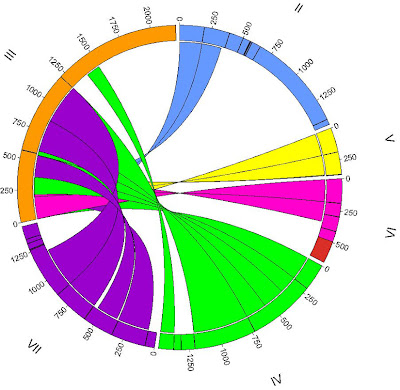Researchers discover how model organism Tetrahymena plays roulette with 7 sexes
 |
| Scanning electron microscope view of two mating Tetrahymena cells. Credit: The ASSET (Advancing Secondary Science Education with Tetrahymena) Program at Cornell University |
It's been more than fifty years since scientists discovered that the single-celled organism Tetrahymena thermophila has seven sexes. But in all that time, they've never known how each cell's sex, or "mating type," is determined; now they do. The new findings are published 26 March in the open access journal PLOS Biology. By identifying Tetrahymena's long-unknown mating-type genes, a team of UC Santa Barbara biologists, with research colleagues in the Institute of Hydrobiology of the Chinese Academy of Sciences, and in the J. Craig Venter Institute, also uncovered the unusual process of DNA rearrangements needed for sex determination in this organism. The discovery has potential human health implications ranging from tissue transplantation to cancer, including allorecognition—the ability of an organism to distinguish its own tissues from those of another—which can be a first line of defense against infection and illness.
In the study, the scientists show that in this multi-sexed, single-celled organism, the sex of the progeny is randomly determined by a series of "cut and paste" genomic recombination events that assemble one complete gene pair and delete all others.
"We found a pair of genes that have a specific sequence which is different for each mating type," said Eduardo Orias, a research professor emeritus and part of the UCSB team. "They are very similar genes—clearly related to one another, going back probably to a common ancestor—but they have become different. And each is different in a specific way that determines the mating type of the cell."
Each unicellular Tetrahymena boasts two nuclei: the 'germline nucleus' and the 'somatic nucleus'. Genetic information for progeny cells is stored in the former, analogous to ovaries or testes in humans, while genes are actively transcribed in the latter, the "working copy" nucleus. The sex of the progeny is determined during mating, when fertilization results in new germline and somatic nuclei that are made using contributions from the germline nucleus of each parent.
The authors found that the germline nucleus contains a tandem array of similarly organized but incomplete gene pairs—one for each mating type (although Tetrahymena have seven sexes, the particular cell line used in this study has just six). In the new somatic nucleus, a single complete gene pair is assembled when DNA segments from each end of this array are fused to one of the six incomplete pairs, and the remaining five are deleted. This precise but random rearrangement leaves the new cell with exactly one gene pair—and one mating type.
"The mating type of the 'parents' has no influence whatsoever on the sex of the progeny," Orias said. "It's completely random, as if they had roulette wheel with six numbers and wherever the marble ends up is what they get. By chance they may have same mating type as the parents—but it's only by chance. It's a fascinating system."
"By understanding this process better in Tetrahymena, what we learn ultimately may be of use in medicine," Orias said. "Tetrahymena has about as many genes as the human genome. For thousands of those genes you can recognize the sequence similarity to corresponding genes in the human genome with the same biological function. That's what makes it a valuable organism to investigate important biological questions."






